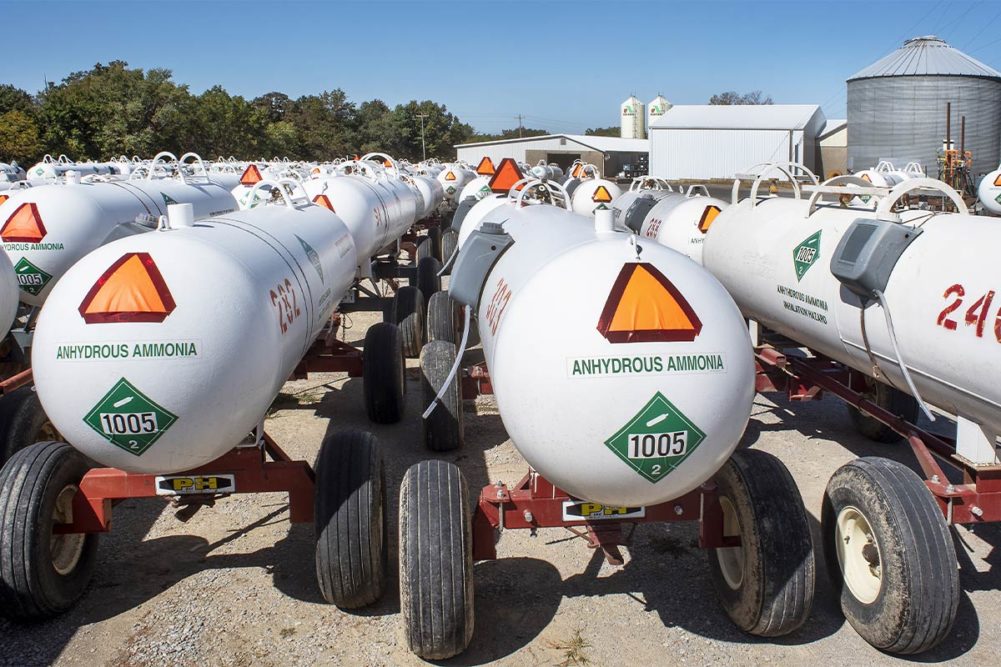KANSAS CITY, MO. — Fertilizer may have been thought of by some as a four-letter word in the past, but this year that word is H-E-L-P due to tight supplies and soaring prices. Supplies, or lack thereof, are driving crop production costs upward and may impact planted area in 2022, especially for corn with its high fertilizer (nitrogen) requirements and a high breakeven point.
Several factors have combined to limit supplies and inflate prices of nitrogen, the primary fertilizer applied to “grassy” crops such as corn and wheat, as well as other key fertilizers, including phosphorus and potassium (potash). Fertilizer production in the region responsible for 60% of US ammonia (nitrogen) output was disrupted last winter by arctic weather across the South and in late summer by Hurricane Ida. Prices of natural gas, a primary input that accounts for about 80% of the variable cost of nitrogen fertilizer, have skyrocketed. Key producing countries have curbed production and exports. Soaring freight costs and logistics snarls have added to the disruption in the fertilizer industry.
Global prices of nitrogen in November exceeded $1,000 per tonne for the first time ever, according to Reuters. The cost to produce a ton of ammonia (a popular form of nitrogen fertilizer) currently is $1,000 compared with $110 last summer, Svein Tore Holsether, chief executive officer of Oslo, Norway-based fertilizer maker Yara International, told Fortune magazine on the sidelines of the COP26 climate conference in Glasgow, Scotland. Yara has reduced its ammonia production by 40% since September due to high energy costs.
Holsether and others have warned that global high prices and tight supplies of fertilizer will contribute to rising food price inflation and may result in global food shortages in the coming year. Global food prices were at a 10-year high in October, according to the Food and Agriculture Organization of the United Nations. The Financial Times noted in a recent column that the last time fertilizer prices spiked like this year was in 2008. But the difference this year is in some parts of the world climate policy has limited funds available to expand natural gas production, which was the supply “bailout” in the past.
Nitrogen fertilizer sales in 2020 were $53 billion globally and are at least 80% higher this year, according to Argus Media. In Nov. 3 testimony at a House Agriculture Committee hearing on “The Immediate Challenges to our Nation’s Food Supply Chain,” Corey Rosenbusch, president and chief executive officer of The Fertilizer Institute, stressed that the fertilizer situation must be “considered within a global context.”
“Nearly 44% of all fertilizers produced globally are exported,” Rosenbusch said. “Moving this material from production facilities to farms requires virtually every mode of transportation.”
Disruptions in countries that are major fertilizer producers, such as Belarus for potash and China for phosphate and nitrogen, affect the global fertilizer supply chain even if they are not major suppliers to the United States, he said. China, which accounts for about a third of the global supply of urea nitrogen fertilizer, has banned phosphate and urea exports until June 2022 after reducing or stopping production to conserve electricity.
Farmers in some countries, including India, have turned to the black market in some cases to secure fertilizer at exorbitant prices, according to industry reports. In the United States, farmers likely won’t turn to the fertilizer black market, but they certainly will be affected.
StoneX recently indicated wholesale anhydrous ammonia nitrogen prices in the Midwest in October had risen about 65% in just over a month’s time. As with most things market related, there are disagreements about how farmers will respond to fertilizer prices. Some expect plantings of corn will decrease because of its high demand for nitrogen. But others note that current high commodity prices, along with limitations from crop rotation schedules, will constrain switching from corn to other crops like soybeans, wheat or cotton. Still others see corn acres increasing in 2022 due to high market prices. Some expect fertilizer supplies will increase and prices will ease in 2022 as the supply chain improves and energy prices level out.
Although nitrogen supplies appear adequate for fall application, a period when many farmers choose to apply the fertilizer rather than cramming another path across fields along with soil preparation and planting in the spring, many growers have delayed purchases due to high prices. At the same time, some farm input sellers have limited forward sales of nitrogen fertilizers due to uncertainty about availability and prices a few months down the road.
The US Department of Agriculture in its initial long-range projections issued in early November (to be revised at the Agricultural Outlook Forum in February 2022) forecast 2022 corn planted area at 92 million acres, down 1.3 million acres from 2021 but up 1.3 million acres from 2020. Soybean planted area was forecast at 87.5 million acres, up 300,000 acres from 2021 and up 4.1 million acres from 2020. Total wheat planted area was projected at 49 million acres, up 2.3 million acres from 2021 and up 4.5 million acres from 2020.
Steve Freed, ADM Investor Services, Inc., Chicago, said he was hearing that most farmers will plant their normal crop rotation in 2022, noting that growers are in “pretty good financial position” after this year’s strong crop prices. Some predict the cost per acre to produce corn may rise by a third or more due mainly to high fertilizer prices, assuming farmers can get supplies.
Read more about supply chain topics affecting the industry on our Operations page.




